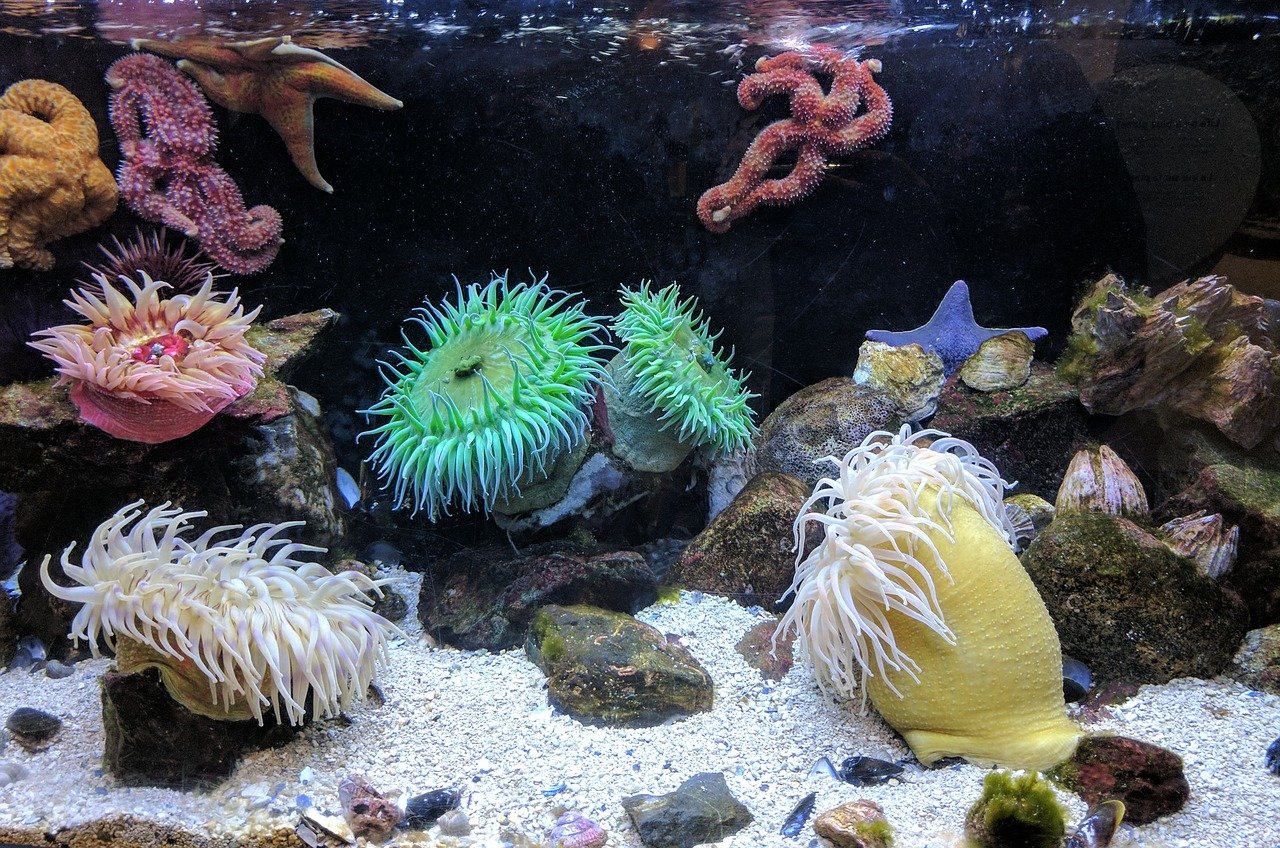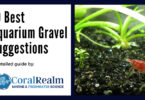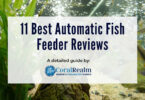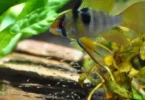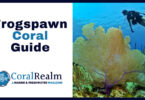Last Updated on February 10, 2023 by Matt
Keeping sea anemones in a reef tank poses its own unique difficulties, but the benefits are large. Sea anemones are amazing creatures which can really raise a reef tank to the next level. However anemone care can be difficult.
A reef tank is a fantastic addition to any home, not just because it is a small piece of a rare and wondrous ecosystem, but also because the array of different creatures and setups that are available are almost endless. One of the possibilities is to keep sea anemones in your reef tank.
In this article we will aim to give you the information you need to care for sea anemones successfully in your reef tank.
IN THIS ARTICLE
Brief Overview of Sea Anemones
Sea anemones are marine predatory invertebrates of the order Actiniaria. They are cnidarians, related to the corals, jellyfish, and hydra.
In typical sea anemones a single polyp attaches itself to a hard rocky substrate, although some prefer soft sand and others are floating. The polyp has a central trunk, which is topped with an opening that serves as both mouth and anus. This opening is ringed by many tentacles covered with cnidocytes which sting and disarm prey which is then dragged into the mouth. The tentacles can be retracted into the columnar trunk for protection; this is often seen in anemones in rock pools.
Many species of sea anemone have a symbiotic relationship with zoochlorella or zooxanthellae algae, much like corals do. This relationship provides the anemone with additional nutrients. Some sea anemones also have symbiotic relationships with shrimp and other crustaceans, but by far the most iconic symbiotic relationship that anemones have are with clownfish.
Unlike other cnidarians sea anemones lack a free swimming medusa larval stage. Instead mature polyps release eggs and sperm into the water column. The fertilized eggs then hatch into planktonic planula larva which search for a suitable place to colonize and grow into a polyp. In some anemones sexes are distinct, and others are hermaphrodites.
The vast majority of sea anemone species are sessile and attach themselves to a hard substrate via their pedal disc, and stay in one place for weeks or months. However some burrow in soft sediment.
While anemones are sessile, they do have the ability to move. They can move on their bases much like a gastropod mollusk like a snail or slug moves, a wave of contraction propelling them forwards. Movement can be very slow, almost imperceivable to the naked eye, but time-lapse photography can show how far they are able to move. If this is too slow, or they need rapid relocation, they can also cut themselves loose from the rock and drift to a new location. Some species can even swim!
Sea anemones feed on anything of an appropriate size that swims by or is drawn in by the current. Prey can be planktonic animals, to larger prey such as crabs, mollusks, and small fish. Prey is caught by the tentacles and immobilized by the stinging cells and then moved to the mouth and thrust into the stomach. Their lips can extend to consume large prey.
Sea Anemone Care Tank Requirements

Contrary to popular opinion, sea anemones can actually get to very large sizes; the largest species can reach 6 feet wide!
Therefore as large an aquarium as you can manage should be the tank size that you look for, with a minimum of a 30 gallon tank. 30 gallons is the minimum, a larger tank will give them more rock to inhabit, and more water can help to prevent swings in chemistry.
Sea anemones should be allowed two to four large rocks on which to attach themselves, and that also allows for some movement.
The water temperature should be kept between 75 – 82.5ºF (24 – 28ºC). Be careful of the aquarium heater though, as it can burn the anemones tentacles. If and where possible keep the heater in the sump tank, or in a separate filtration compartment. Like most tropical reef organisms salinity levels should be between a specific gravity range 1.020 to 1.026. A pH range of between 8.1 and 8.3 is the ideal. A carbonate hardness of 7-12 dKH should be maintained, but check the specific species.
Anemones need very clean water, so a strong filtration system such as a canister filter should be maintained, along with a protein skimmer. Regular water testing should be undertaken with a good testing kit. Phosphate, ammonia, and nitrite concentrations should be kept to 0 ppm, and nitrate concentrations should be kept to under 2 ppm. Phosphate removers can be used to reduce levels. Along with the filtration systems, a water change of 15-30% should be undertaken every 3-4 weeks to maintain balance. Water changes can be made easier using a product like the Python water changer. If you use RODI water or distilled water ensure to add reef salt and trace elements like magnesium and calcium in correct measurements.
As sea anemones get nutrients from their symbiotic algae, they have the same lighting requirements as SPS corals and LPS corals. Bright and high intensity lighting is best; try and find LED lighting which emits the spectrum required for coral and anemone growth.
Water flow is also an important consideration in sea anemone care. They require at least low to moderate flow, as water flow brings the organisms they feed on. Therefore water flow makes the tank feel more natural and is actually important in maintaining health. Some species need high water flow, so ensure that you know the requirements of the specific anemone you are looking at. Make sure that there is no way the anemone’s tentacles will get caught in any wave makers that are in the tank.
Best Sea Anemones for a Reef Tank
Bubble Tip Anemone (Entacmaea quadricolor) – This species grows up to 12 inches in diameter, although this depends on many factors such as lighting. Generally have an orange or red coloration. Need firm rock and stone to adhere to. They are easy to keep and care for, however they do need a 100 gallon tank.
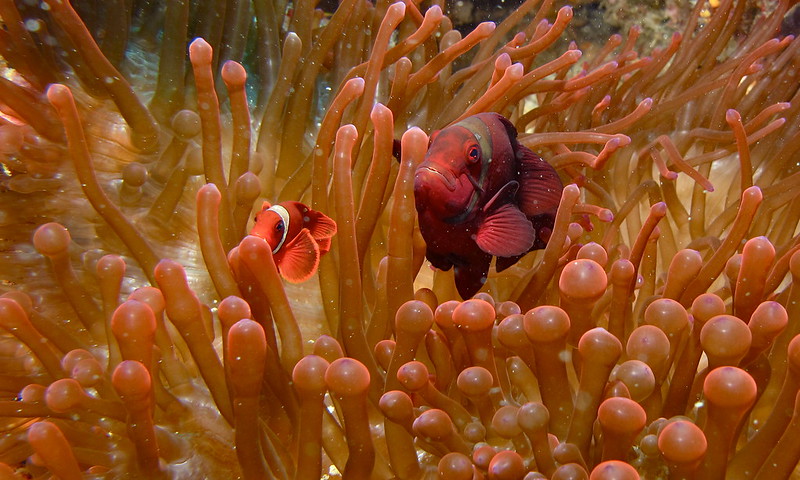
Credit: Bernard Dupont (Flickr)
Sebae Sea Anemone (Heteractis crispa) – Grow up to 12 inches in diameter, and have a purple coloration. Live singly from depths of 10-100 feet with the polyp in crevices with only the tentacles emerging. Sebae anemones can attach themselves to different substrates, such as hard rock, rubble, or the substrate, where they will burrow and attach themselves to the base of the tank. As such the substrate should be at least 4 inches deep. Are very difficult to care for.
Pizza Anemone (Cryptodendrum adhaesivum) – Found throughout the Indian Ocean and western Pacific Ocean, this species is so called as they resemble a large flat pizza! Have two types of tentacles; short in the middle and distinctive enlarged edge tentacles. Grows up to 12 inches, and requires a minimum of 50 gallon tank. Has strong sting cells, and can eat small fish.
Beaded Sea Anemone (Heteractis aurora) – Growing to 10 inches in diameter, this species lives on rocky crevices and sandy substrates. Needs a 75 gallon tank with at least 4 inches of substrate. Does pretty well in a tank environment with regular feedings and the appropriate setup.
Magnificent Sea Anemone (Heteractis magnifica) – The second largest species of anemone, reaching 36 inches. It prefers to have its attachment point on open rock where there is good water flow. Can be many colors, though the column is normally blue, brown, green, red, or white and the tentacles are usually brown. Should be placed into the tank first, before corals, as they are likely to roam to find the perfect spot, and will sting and kill anything in the way.
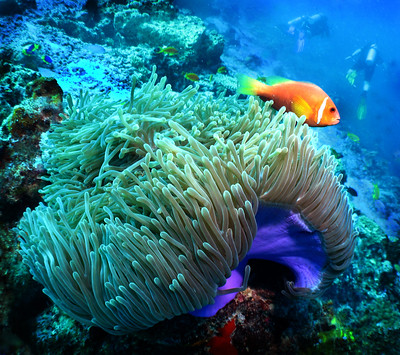
Credit: Piktour UK (Flickr)
Sabae Sea Anemone (Heteractis malu) – An incredibly difficult species that should only be kept by expert aquarists, it is not reef safe as it will sting and kill corals. Needs strong lighting and regular feedings, and a fine substrate at least 8 inches deep. Beautiful coloration, with pale tentacles tipped with magenta.
Corkscrew Sea Anemone (Macrodactyla doreensis) – Has a purple-grey to brown coloration, and is found in shallow waters with the column buried in substrate. Therefore needs at least 5 inches of muddy or sandy substrate. Its tentacles are in a distinctive corkscrew shape.
Giant Carpet Sea Anemone (Stichodactyla gigantea) – A large species reaching 30 inches, the oral disc is usually a tan or pinkish color, with a tan or gray column. Found naturally in substrate or rubble, and does best when provided with a deep sandy substrate in the tank. Needs high intensity lighting and strong water circulation. Not coral safe.
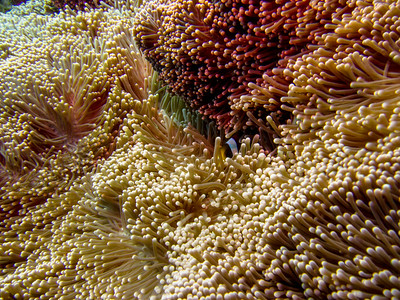
Credit: Ryan McMinds (Flickr)
Haddon’s Sea Anemone (Stichodactyla haddoni) – Another large species reaching 30 inches, it needs a deep substrate of 4 inches. Very pretty with short tentacles, its oral disc is usually green, light brown, or yellow, with the tips of the tentacles green, grey, yellow or pink.
Merten’s Carpet Sea Anemone (Stichodactyla mertensii) – A large species that can exceed 36 inches, it is a beautiful animal. The column is usually whitish or tan with bumps that are tan, orange or magenta. Oral disc is green, cream or yellow in color with tentacles that are tipped in white, yellow or green. Can eat small fish and will sting coral.
Ensure Symbiotic Relationships
Many sea anemones have symbiotic relationships with crabs, shrimp, and fish. Symbiotic relationships benefit both organisms, so not having one without the other can be to the detriment of both.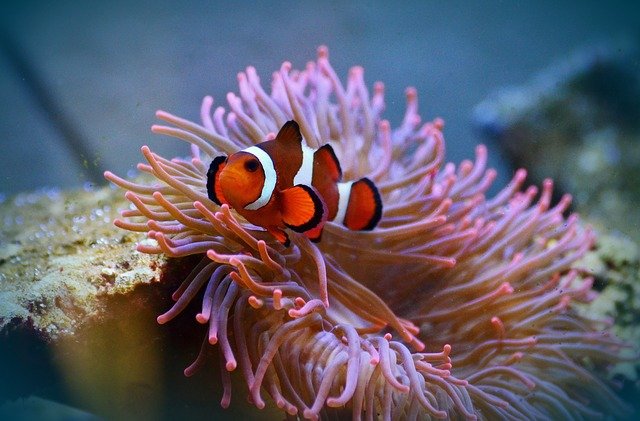
Many sea anemones have relationships with clownfish. Clownfish are brilliant reef inhabitants in their own right, so having clownfish paired with an anemone can lift a reef tank to a whole new level of beauty. The same is seen with shrimp and crabs; having them live and play in the anemone is great to watch and also keeps both healthy!
Shrimp and crabs, especially hermit crabs, feed on the algae and other organisms that grow on the sea anemones tentacles. This growth is very detrimental to the anemone, so having it removed aids in it remaining healthy. Clownfish especially increase the water flow through the polyp and ring of tentacles, which not only increases general health but also increases feeding rates. Studies have shown that sea anemones in conjunction with clownfish live longer, need feeding less, and are generally healthier than those living without this relationship.
The following table shows what clownfish species commonly found sea anemones will host in the aquarium.
| Sea Anemone Species | Symbiotic Clownfish Species |
| Bubble Tip Anemone (Entacmaea quadricolor) | Cinnamon Clownfish (Amphiprion melanopus), Clark’s Yellowtail Clownfish (Amphiprion clarkii), Maroon Clownfish (Premnas biaculeatus), Red Saddle Clownfish (Amphiprion ephippium), Tomato Clownfish (Amphiprion frenatus) |
| Sebae Sea Anemone (Heteractis crispa) | Cinnamon Clownfish (Amphiprion melanopus), Clark’s Yellowtail Clownfish (Amphiprion clarkii), Orange Skunk Clownfish (Amphiprion sandaracinos), Percula Clownfish (Amphiprion percula), Pink Skunk Clownfish (Amphiprion perideraion), Red Saddle Clownfish (Amphiprion ephippium), Saddleback Clownfish (Amphiprion polymnus) |
| Pizza Anemone (Cryptodendrum adhaesivum) | Clark’s Yellowtail Clownfish (Amphiprion clarkii) |
| Beaded Sea Anemone (Heteractis aurora) | Clark’s Yellowtail Clownfish (Amphiprion clarkii) |
| Magnificent Sea Anemone (Heteractis magnifica) | Ocellaris Clownfish (Amphiprion ocellaris), Clark’s Yellowtail Clownfish (Amphiprion clarkii), Percula Clownfish (Amphiprion percula), Pink Skunk Clownfish (Amphiprion perideraion) |
| Sabae Sea Anemone (Heteractis malu) | Clark’s Yellowtail Clownfish (Amphiprion clarkii) |
| Corkscrew Sea Anemone (Macrodactyla doreensis) | Clark’s Yellowtail Clownfish (Amphiprion clarkii), Maroon Clownfish (Premnas biaculeatus), Pink Skunk Clownfish (Amphiprion perideraion) |
| Giant Carpet Sea Anemone (Stichodactyla gigantea) | Ocellaris Clownfish (Amphiprion ocellaris), Clark’s Yellowtail Clownfish (Amphiprion clarkii), Percula Clownfish (Amphiprion percula), Pink Skunk Clownfish (Amphiprion perideraion) |
| Haddon’s Sea Anemone (Stichodactyla haddoni) | Clark’s Yellowtail Clownfish (Amphiprion clarkii), Saddleback Clownfish (Amphiprion polymnus), Sebae Clownfish (Amphiprion sebae) |
| Merten’s Carpet Sea Anemone (Stichodactyla mertensii) | Clark’s Yellowtail Clownfish (Amphiprion clarkii), Orange Skunk Clownfish (Amphiprion sandaracinos), Percula Clownfish (Amphiprion percula), Skunk Clownfish (Amphiprion akallopisos) |
Sea Anemone Feeding

Sea anemones should be fed at least once a week, however larger anemones may need more regular feeding. Once a week is the minimum, lots of species need to be fed two to three times a week. The more you feed an anemone the faster it will grow.
Anemones can be fed meaty foods such as crab, fish, shrimp, and worms. Chopped up pieces of seafood are perfect for anemones; they can be target fed to ensure that no fish steal the meal!
Ideally the food should be in about 2 inch pieces, but this does vary depending on the size of the anemone you’re feeding. Frozen foods are absolutely fine for anemones, but they need to be defrosted before being fed to them. There are target feeders that are perfect for feeding anemones that can be found easily online, such as these:
Check out this anemone feeding video!
Easy and Common Mistakes in Anemone Care
Perhaps the most common mistake is placing an anemone into a tank that hasn’t matured properly. A fish tank needs time to properly cycle, that is to establish good bacteria so the nitrogen cycle is running smoothly in your tank system. Aquarium bacteria supplements can speed this process along. Anemones don’t respond well to fluctuations in water chemistry, so you need to ensure that the tank is stable. Just because a tank has finished cycling doesn’t mean that it has matured; waiting an extra few weeks or months can go a long way.
Different sea anemones can prefer different attachment points, so make sure that you know which substrate the anemone you want needs. A common mistake is providing plenty of rock, only for the anemone to need a deep substrate.
While anemones are sessile, they can and will move to find the perfect spot, so don’t freak out if it has moved position! Because of this, it is better if the anemone is put into the tank first before other sessile invertebrates such as corals. Anemones sting, and may kill corals they come into contact with.
Always remember that anemones need feeding! While they have symbiotic algae that provide them with nutrients from photosynthesis, they also need to be fed in their own right.
Conclusion
Sea anemones can be a little tricky to keep, but they are absolutely stunning creatures that look fantastic in a reef tank.
Always research the anemone that you want in your tank so that you can provide it with the perfect home to give it the best chance of surviving and thriving in your tank.

